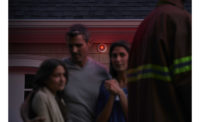During my first year with SDM, I uncomfortably admit that in the mid-1980s, I was sent out with an installer to observe a burglar alarm installation in a small business. Although I didn’t know it then, I later learned that the installer’s practice of laying the wire on the top of the drop-tile ceiling, in the plenum air space between the true ceiling and the drop ceiling, was dangerous and prohibited by the National Electrical Code, NFPA 70.
The National Electrical Code, or NEC, “protects the public by establishing requirements for electrical wiring and equipment in virtually all buildings,” states the National Fire Protection Association, which publishes the code.
A common myth is that the code only deals with high-voltage electricity. Not true. NEC also addresses low-voltage wiring applications and practices, and this is the area with which security installation companies must know and comply.
The three primary sections with which low-voltage installers need to be concerned are Article 725, which covers remote control and power-limited circuits (burglar alarm, access control and intercom circuits); Article 760, which covers fire alarm circuits; and Article 800, which covers communication circuits such as LANs. One of the most important things the NEC does is categorizes the cable referenced within each Article by its intended use, such as general-purpose, riser, plenum, etc.
What’s more, NEC also covers the methodology of installing the cable, notes Paul Baran, corporate security consultant with Bosch Security Systems, Fairport, N.Y., and chairman of the National Training School (NTS). Proper grounding methods, allowable means of cable support, and requirements for installations in moist or hazardous environments are examples of the breadth and depth of information that technicians will find in NEC.
“One of the errors I see in this industry is people wiring in a hazardous or volatile location and not using the methodology that you need to wire in those areas,” Baran explains. “Your equipment -— the contact opening and closing — could cause an explosion in those areas. Your wiring needs to be intrinsically safe.”
Safety is the primary reason the NEC exists, explains Bryan McLane, vice president of sales at National Training Center, Las Vegas. Thus, cables are classified and rated for their intended applications in a hierarchical structure due to their ability to retard the spread of flames.
For example, in Article 725, which covers burglar alarm cable, the designation “CL” is used. The most common types of CL cable are CL2 and CL3, McLane says. This cable can be run horizontally in a general-purpose application.
The next step up is riser cable, having a designation of CL2R or CL3R. This cable should be used for vertical runs, typically in a raceway between floors in a building.
“The key difference about riser-rated cable is that it does not conduct a flame very easily and that’s the whole point of using it vertically. It retards the flame and does not allow it to travel easily between floors,” McLane points out.
The next step up is plenum cable, for use in an environmental air space where the air return is open to the ceiling rather than contained by individual ductwork. The designations on plenum cables within Article 725 are CL2P and CL3P.
“When you have cable in that air space you have to have a cable that is more fire resistant and will not produce toxic smoke,” McLane says. “When it does burn, it produces less toxic smoke than conventional cable does.”
The NEC applies the same designation structure to cables covered in Article 760 — fire alarm. The main type of cable used for fire alarms is FPL — fire power limited. There are FPL cables designated for general-purpose, for riser and for plenum applications.
The NEC designations follow a hierarchy on which installers can substitute one way, but not the other. For example, they can use a plenum-rated cable in a riser application or in a general-purpose application, but they cannot use a general-purpose cable in a riser or plenum application, McLane stresses.
What Can Happen if You Don't Abide?
Seems simple, yet a minority of security installers regularly incur unintentional — and sometimes intentional — infractions against the code. One issue is cost.
“The first thing to impact any design is the cost,” Baran concedes. “The cost goes up as you go into specialized cabling. The riser is a couple bucks more a roll [than general-purpose] and the plenum is more than that. Most of the time [security companies] can’t pass on that cost to the customer, because they weren’t aware of it to begin with. There needs to be an education process,” he believes.
In fact, it may be more costly not to follow NEC; the consequences of not using the proper cable for its intended application are steep. If installers downgrade the cable for a job, they are risking two things, McLane acknowledges.
“If it’s a fire alarm life-safety situation, and they use the wrong cable, they are opening themselves up to liability. If it comes out in court, they could be sued both criminally and financially,” McLane says. “The other thing is if the job is inspected — and most are — and the inspector finds they are using the wrong type of cable, he can make them remove it and install the right cable. Surely the customer is not going to pay for that.”
What’s more, inspections may cover not only the type of cable used, but the manner in which that cable was installed — these are all part of NEC.
“NEC goes beyond just specifying types of wire for particular projects; it’s a bible when it comes to the electrical industry,” Baran says.
He says that although NEC Articles 725, 760 and 800 are the primary ones concerning the low-voltage security industry, other sections are regularly referenced, such as Article 250 on grounding. There are many, many requirements concerning the way in which wire is supported, as well.
For example, the NEC requires that all cable must be supported by the building structure. When installers lay cable on top of a drop ceiling, as mine did, it is not permissible by the NEC because the drop ceiling is not part of the true building structure.
“That’s a fire safety issue, because if there’s a fire and that ceiling drops down, you’re going to get hot molten cable dropping down, too. That ceiling will eventually give way and all that heavy copper cable will drop down,” McLane explains.
Another important point NEC addresses is abandoned cable. Cables that are not used and not properly identified must be removed. “If the cables are there and not properly identified, somebody could use it for the purpose it wasn’t identified for,” McLane says. “Those abandoned cables must be removed, but that’s a gray area as to whose responsibility it is to remove them.”
What's in the Next Edition?
The NEC is updated every three years; the most recent edition available is 2005. The instructors interviewed for this article do not foresee major changes to the low-voltage sections of NEC in the 2008 edition.
“The principles that govern the properties of wire and the ability for wire to carry electrical data and voltages have been constant,” Baran says. “We are at a plateau right now when it comes to the wiring and there’s no need to modify the existing codes or standards going forward.
“The systems that are going in today still have to deal with those types of wiring structures and hierarchy. You’re going to see a difference when it comes to network- and IP-based systems, but not now. As we go further and further into the next couple of years, we are going to see more and more data circuits being used,” Baran foretells.
That may create the need for more vigorous changes between NEC editions, and may create a greater need for technicians to become further educated on this important safety code.
Learn More
At the National Training School, at which Baran is both chairman and an instructor, the NEC is covered “no matter which module you take — advanced, intermediate, or entry-level,” he says.
At the National Training Center, where McLane teaches, several courses, including a NICET fire alarm class and a new fire alarm codes class, cover the NEC. In addition, “In every one of our classes, we always touch on the NEC because we feel it’s an extremely critical code for people to know about,” McLane says. “It is covered in all of our books as well.”
Here's What the NEC Requires in Low-Voltage Wiring Jobs
Does the National Electrical Code, NFPA 70, apply to low-voltage systems? Absolutely, says Bryan McLane, vice president of sales at National Training Center, Las Vegas. “Every industry professional should have a copy of the NEC, and be familiar with the requirements of the code,” McLane stresses.
NEC governs not only the type of cable that can be used for the type of application, but also how that cable is installed. According to McLane, the NEC requirements state:
- All wiring shall be attached to the permanent building structure.
- All low-voltage electrical work shall be done in a workmanlike manner (neat and organized).
- Penetrations in fire barriers shall be sealed.
- All splices and terminations shall be done in appropriate electrical boxes.
- Low-voltage wiring shall not be strapped to conduit.
- Low-voltage wiring shall not be attached to sprinkler piping.
- Wire shall not be run on top of the drop ceiling panels.
- Wiring shall not be attached to the support grid for the drop ceiling.
For more information about the National Electrical Code, visit www.nfpa.org or call (617) 770-3000.
The Push for Plenum
There is a difference of opinion about which fire disaster initiated the increased use of plenum cable in the United States.
According to NTC Brown Book, Fire Alarm Systems Design & Installation, the widespread emphasis on the use of plenum-rated cable started with the MGM Grand hotel fire in Las Vegas in 1980. During that fire, which originated in one section of the building, toxic fumes from the burning non-plenum cable, as well as other burning materials, were carried to other parts of the building that were not on fire. More than 80 people died as a result of breathing the toxic fumes.
Others believe the incident was a fire that occurred in the early 1970s in a telephone switching station in Chicago. Employees’ bodies were found near an exit door of the building; apparently they had been unable to escape because they were overcome by toxic fumes emitted from the burning wire.
“A study found that the PVC jacket on standard wire was a toxin at high temperatures,” says Paul Baran, corporate security consultant with Bosch Security Systems, Fairport, N.Y., and chairman of the National Training School (NTS). “A switching office is full of wires. The whole room was plenum. A colorless, odorless gas was being emitted.”
Both incidents are prime examples of why the proper use of cable, as outlined by the National Electrical Code, is necessary.




